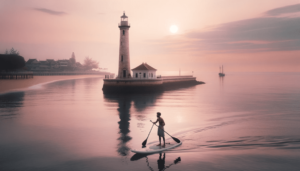When it comes to whitewater paddleboarding, proper gear and safety are paramount. Without the right equipment and precautions, the adventure can quickly turn into a dangerous situation.
From helmets and life jackets to understanding the risks involved, this article will provide expert tips and essential information for a safe and exhilarating whitewater paddleboarding experience.
So, gear up, stay safe, and get ready to ride the rapids with confidence.
Importance of Proper Gear
Proper gear is essential for ensuring the safety and success of whitewater paddleboarders. When it comes to whitewater paddleboarding, the right gear can make all the difference. From choosing the right paddleboard to maintaining your equipment, having the proper gear is crucial for a safe and enjoyable experience on the water.
Gear maintenance is an important aspect of whitewater paddleboarding. Regularly inspecting and maintaining your gear will help prolong its lifespan and ensure that it functions properly when you need it most. This includes checking for any signs of wear and tear, such as cracks or leaks in your paddleboard, and addressing them promptly. Additionally, keeping your gear clean and properly stored will help prevent damage and extend its usability.
Choosing the right gear is equally important. It’s essential to select a paddleboard that’s appropriate for whitewater conditions, with features like reinforced construction and stability. Paddles should be lightweight and durable, allowing for efficient strokes and maneuverability. Wearing a proper personal flotation device (PFD) is non-negotiable, as it can save your life in case of an emergency.
By prioritizing gear maintenance and selecting the right equipment, whitewater paddleboarders can enjoy the freedom and thrill of conquering rapids while staying safe and prepared.
Safety Precautions for Whitewater Paddleboarding
Safety precautions are essential when it comes to whitewater paddleboarding.
One of the most crucial aspects is having the proper safety equipment, such as a helmet, life jacket, and leash.
Additionally, understanding and practicing proper paddling techniques is important to navigate the unpredictable and fast-moving water.
Essential Safety Equipment
When engaging in whitewater paddleboarding, it’s crucial to have the necessary safety equipment in order to mitigate potential risks and ensure a safe experience.
Safety equipment selection is an important aspect of preparing for whitewater paddleboarding. A properly fitted personal flotation device (PFD) is essential to keep the paddler afloat in case of a fall or accident.
A helmet is another crucial piece of equipment that protects the head from potential impacts with rocks or other objects in the water.
Additionally, a leash is necessary to keep the paddleboard attached to the paddler and prevent it from floating away in fast-moving currents.
It’s important to avoid common safety mistakes such as neglecting to wear a PFD or using a helmet that doesn’t fit properly.
Proper Technique Importance
To ensure a safe experience in whitewater paddleboarding, it’s crucial for paddlers to master proper technique and take necessary safety precautions.
Proper technique mastery not only enhances the paddler’s performance but also minimizes the risk of accidents and injuries. By learning the correct paddle strokes, body positioning, and balance techniques, paddlers can navigate through turbulent waters more effectively and maintain stability on their boards. This allows them to react quickly to changing conditions and maneuver through obstacles with ease.
The benefits of proper technique extend beyond safety. Paddlers who’ve mastered the art of paddleboarding in whitewater are able to fully enjoy the freedom and adrenaline rush that comes with the sport. So, by investing time and effort into learning and refining their technique, paddlers can unlock the true potential of whitewater paddleboarding while ensuring their safety.
Potential Risks Involved
Mastering proper technique in whitewater paddleboarding not only enhances a paddler’s performance but also mitigates the potential risks involved, allowing for a safer and more enjoyable experience on the water.
Whitewater paddleboarding, while thrilling and adventurous, comes with its own set of potential dangers. To ensure safety, paddlers should take the following safety measures:
- Always wear a personal flotation device (PFD) to stay afloat in case of a fall or accident.
- Familiarize yourself with the river’s characteristics and flow patterns before attempting to paddleboard, as different rivers pose different challenges.
- Take a whitewater paddleboarding course or receive proper training to learn essential techniques and safety practices.
By being aware of these potential dangers and adhering to these safety measures, paddlers can minimize risks and maximize the freedom and exhilaration that whitewater paddleboarding offers.
Now let’s explore the essential equipment for a safe experience.
Essential Equipment for a Safe Experience
Proper gear and safety are crucial for a safe experience in whitewater paddleboarding due to the necessity of equipping oneself with essential equipment. When it comes to gear maintenance, regular checks and proper care are essential to ensure that all equipment is in good working condition. This includes inspecting the paddleboard for any cracks or damage, checking the leash for wear and tear, and ensuring that the life jacket is properly inflated and functioning.
Choosing the right equipment is equally important. It’s essential to pick a paddleboard that’s specifically designed for whitewater conditions, with features like reinforced construction and fins for stability. Additionally, a leash and a properly fitted life jacket are must-haves to ensure safety on the water.
As paddleboarding in whitewater can be unpredictable and challenging, it’s crucial to equip oneself with the appropriate gear to minimize risks and maximize enjoyment. With the right equipment, paddleboarders can confidently navigate through rapids and obstacles, knowing that they’ve taken the necessary precautions for their safety.
Transitioning into the next section, personal protective gear plays a vital role in ensuring a safe experience in whitewater paddleboarding.
The Role of Personal Protective Gear
Personal protective gear plays a crucial role in ensuring the safety of individuals participating in whitewater paddleboarding. It serves as a protective barrier against potential hazards and minimizes the risk of injuries.
From a well-fitted helmet to a sturdy life jacket and appropriate footwear, having the right gear is essential for a safe and enjoyable paddleboarding experience.
Importance of Safety Gear
Using the right gear is crucial for safety in whitewater paddleboarding, especially when it comes to personal protective equipment. Here are three reasons why safety gear is essential for a worry-free paddleboarding experience:
-
Protection: Personal protective gear such as helmets and life jackets provide crucial protection in case of falls or accidents. They can prevent head injuries and keep you afloat in turbulent waters.
-
Visibility: Brightly colored safety gear increases visibility, making it easier for rescue teams to locate you in case of emergency. This is particularly important in fast-moving rivers or low light conditions.
-
Peace of Mind: Wearing safety gear gives you the confidence to navigate challenging whitewater confidently. It allows you to focus on the adventure and enjoy the freedom of paddleboarding knowing that you’re prepared for any unexpected situations.
With the importance of safety gear established, let’s now explore the different types of gear available for paddleboarding.
Gear for Paddleboarding
When engaging in whitewater paddleboarding, the role of personal protective gear is crucial for ensuring safety and minimizing risks. The right paddleboarding gear not only enhances performance but also provides essential protection against potential hazards.
Paddleboarding gear includes a variety of items designed to keep you safe on the water. One of the most important pieces of gear is a personal flotation device (PFD), which helps keep you afloat in case of a fall or accident.
A helmet is another essential item, as it protects your head from potential impact with rocks or other objects in the water.
Additionally, wearing a wetsuit or drysuit can help regulate body temperature and protect against hypothermia in colder conditions.
By investing in proper paddleboarding gear, you can enjoy the freedom of the water while staying safe.
Now let’s explore the essential protective gear needed for whitewater paddleboarding.
Protective Gear Essentials
How essential is the role of personal protective gear in whitewater paddleboarding?
When it comes to navigating the unpredictable waters of whitewater paddleboarding, having the right protective gear is crucial. Here are three key items that every paddleboarder should consider for their safety and peace of mind:
-
Helmet: Protecting the head from potential impact with rocks or other objects is paramount in whitewater paddleboarding. A sturdy helmet can prevent serious head injuries and ensure a safer experience on the water.
-
Personal Floatation Device (PFD): A PFD is essential for buoyancy and safety in case of an accidental fall. It keeps the paddleboarder afloat and provides reassurance, especially in fast-moving water or turbulent conditions.
-
Protective Clothing: Wearing the right clothing, such as a wetsuit or drysuit, can help regulate body temperature, protect against hypothermia, and reduce the risk of cuts or abrasions from rocks or debris.
Understanding the Risks Involved
Understanding the risks involved in whitewater paddleboarding is essential for ensuring the safety of individuals. Whitewater paddleboarding is an exhilarating activity that combines the thrill of whitewater rafting with the balance and control of paddleboarding. However, it isn’t without its dangers.
One of the most important aspects of understanding the dangers of whitewater paddleboarding is recognizing the power and unpredictability of the river. Whitewater rivers can be fast-moving and turbulent, with strong currents and hidden obstacles. Without proper knowledge and experience, individuals can easily get swept away or collide with rocks and other hazards.
Risk management techniques play a crucial role in mitigating these dangers. It’s important to assess the river conditions, including water levels, rapids, and potential hazards, before embarking on a whitewater paddleboarding adventure. Additionally, individuals should have a solid understanding of paddleboarding techniques and be able to maneuver effectively in different water conditions.
By understanding the risks involved and implementing effective risk management techniques, individuals can significantly reduce the likelihood of accidents and injuries. However, it’s important to remember that even with proper precautions, whitewater paddleboarding still carries inherent risks.
With a clear understanding of the risks involved in whitewater paddleboarding, it’s now time to explore expert tips for safe paddleboarding in the next section. These tips will provide valuable insights and practical advice to ensure a safe and enjoyable experience on the water.
Expert Tips for Safe Whitewater Paddleboarding
Building upon the understanding of the risks involved in whitewater paddleboarding, it’s crucial to implement expert tips for ensuring a safe experience on the water. Here are three expert tips and safe techniques to help you paddleboard safely in whitewater:
-
Choose the right gear: Invest in a high-quality whitewater paddleboard that’s specifically designed for navigating rapids. Look for a board that’s sturdy, stable, and has reinforced construction to withstand the rough conditions. Additionally, make sure to wear a properly fitting personal flotation device (PFD) at all times to keep you buoyant and safe in case of a fall.
-
Learn proper paddle techniques: Take the time to learn and practice proper paddle techniques for whitewater paddleboarding. This includes mastering your forward stroke, turning strokes, and bracing techniques. Developing these skills will help you maintain control and balance while navigating through turbulent waters.
-
Take a whitewater paddleboarding course: Consider enrolling in a whitewater paddleboarding course or hiring an experienced instructor. They can teach you advanced techniques, safety protocols, and help you develop the necessary skills to navigate challenging rapids. Taking a course won’t only enhance your safety but also boost your confidence on the water.
Frequently Asked Questions
How Much Does Proper Gear for Whitewater Paddleboarding Typically Cost?
Proper gear for whitewater paddleboarding typically costs around $300 to $500. While this may seem expensive, investing in quality equipment is crucial for safety and can ultimately be more affordable than dealing with potential accidents or injuries.
Can I Use Regular Paddleboarding Gear for Whitewater Paddleboarding?
Using regular paddleboarding gear for whitewater paddleboarding has both advantages and disadvantages. It may be cost-effective and convenient, but it lacks the necessary safety features and durability required for challenging river conditions.
Are There Any Specific Certifications or Qualifications Required for Whitewater Paddleboarding?
Certifications and qualifications are not specifically required for whitewater paddleboarding, but proper gear and safety are crucial. It’s important to have the right equipment and knowledge to navigate the challenges of whitewater environments.
What Are the Most Common Injuries Associated With Whitewater Paddleboarding?
Common injuries in whitewater paddleboarding include sprains, strains, bruises, and fractures. To prevent these, safety precautions like wearing proper gear, such as a helmet and PFD, and practicing proper techniques are crucial.
How Do I Properly Maintain and Care for My Whitewater Paddleboarding Gear?
Proper gear maintenance and equipment care are essential for whitewater paddleboarding. Regularly check and clean gear, store it in a dry and safe place, and promptly repair any damages. This ensures optimal performance and safety on the water.


